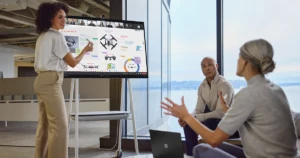
A time to pivot: What comes next for retail
 The past year has accelerated the push toward digital transformation for many industries, maybe none more than retail. From operations to manufacturing supply chain to customer experience, there is no facet of retail that is not facing the imperative to pivot or perish.
The past year has accelerated the push toward digital transformation for many industries, maybe none more than retail. From operations to manufacturing supply chain to customer experience, there is no facet of retail that is not facing the imperative to pivot or perish.
A study by Boston Consulting Group found that investing in key resilience tools could save 15–25% in aggregated costs. Yet, they also discovered that most companies are not fully realizing the ROI they expect from their digital transformation efforts. The key to recouping investment is focusing on the right pillars.
For retail engagement, the next focal points are customer personalization and safety. We see retail continuing to follow the trend of the past few years toward greater personalization of the customer experience.
Safety: An elevated priority in customer obsession
At the same time, the pandemic has brought to the forefront a new priority in our customer obsession: safety. Putting the customer at the center of everything we do has traditionally meant constantly asking, “Are we meeting, and even anticipating, the customer’s needs?” Now, we must keep a new question at top of mind: “Does the customer feel safe?” There is a fresh sense of urgency to implement protocols across the retail experience that protect both customers and employees.
Appealing to customers means creating more robust online offerings as well as ensuring that brick-and-mortar customer experiences have additional protections in place. Winning the web will mean leveraging technology to create more responsive and immersive shopping experiences. Bringing people back into stores with confidence will require measures that allow interactions that feel safe, from highlighting hygiene protocols to implementing technology that enables contactless payment. Sustaining customer-brand loyalty will require these online and in-store enhancements as well as creative hybrid solutions, like curbside pickup facilitated by a seamless online purchasing experience.
While enhancing the customer experience, an emphasis on safety also enables retailers to protect their most valued asset: the people who work for them. In a constantly changing landscape, leaders must have clear data to manage safer reopenings. Location readiness for phased transitions is determined by local data on infection rates and supply availability. There must be proactive plans in place for employee health monitoring as well as workplace care management. The customizable, low-code/no-code dashboards built using Power Apps, Power BI, and Power Automate on the Microsoft Power Platform Return to the Workplace solution support safer reopening by unlocking the insights most important for each organization.
What solutions enable employees to feel empowered to deliver their best customer service? And how can the data-driven insights made possible by digital transformation help companies continue to deliver the best customer experience possible?
A case study in customer engagement
Lids is an example of a business that is embracing digital transformation to rise to the next level of customer engagement and personalization. This branded merchandise retailer is best known for its floor-to-ceiling displays of hats in a countless variety of sports team designs. These hats and other branded team merchandise, including many exclusives, sell at more than 1,000 outlets across North America, primarily in shopping malls. CEO Tom Ripley has been a strong supporter of embracing technology as a way of using the retail experience as a “gateway into the future.”
Along with Nick Corthier, the Senior Vice President of Finance, the Lids leadership team implemented Microsoft Dynamics 365 Finance and Operations as well as D365 Store Commerce to bring a new level of visibility and cohesion to their operations. They started out seeking a finance solution that would bring a single line of sight to data siloed in the sales system, buying–merchandising system, and general ledger across online and brick-and-mortar outlets. They quickly recognized an opportunity to leverage the technology to do more.
“[Dynamics 365] integrates not only with different software solutions throughout the company, but different solutions within the store,” says Corthier, explaining how they made the choice to include Dynamics 365 Store Commerce. In addition to enterprise-scale financial reporting and supply–chain visibility, this solution suite supports a mobile point-of-sale experience. This appeals not only to the shop’s young, image-conscious customer base, but it also helps attract and retain high-quality employees. It empowers them to answer questions and see stock availability from the floor, creating greater personal attention and customer engagement. Handheld POS devices also deliver line-busting capabilities to handle surges in holiday traffic more efficiently.
“What D365 Retail brought to us from the get-go is an opportunity to make sure that we could take something well into the future,” Corthier says.
Prepare your retail operations for the future
The companies that thrive in the years ahead will be the companies that have planned to invest in building their resilience. How is your company planning for what comes next in retail? Visit Microsoft at NRF 2021 Forward Together and watch our NRF Big Ideas session with Shelley Bransten, Microsoft Corporate Vice President of Retail and Consumer Goods, to hear firsthand how Microsoft is helping to build more intelligent, resilient, and sustainable retail operations for customers worldwide.




